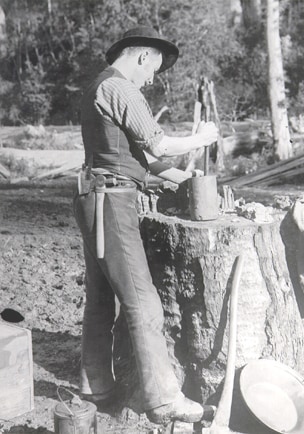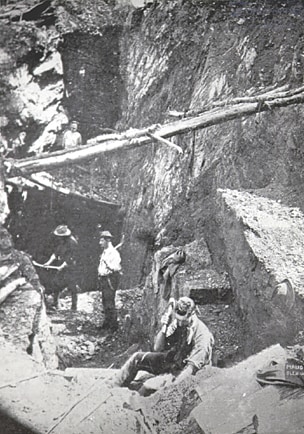Gold diggers

A life of labour
Diggers' life at the goldfields was continual hard labour: dust, mud and backbreaking toil. Many miners had been manual labourers who were chasing dreams of independence from the drudgery of waged work.
Most were itinerant, moving between gold diggings, following rumours of riches further afield.
Mining claims were small (eight by eight feet or twelve by twelve feet) and the typical digger might work as many as ten different claims in four years. Therefore mining methods needed to be cheap and portable.
The early years
The early years of the Victorian goldrushes, from 1851 until the end of the decade, was the era of small, unmechanised alluvial mines that relied on muscle-power and physical endurance.
Diggers arrived at the goldfields with little mining experience. By watching other miners and veterans from the Californian rushes they learnt the techniques of panning, ground sluicing, cradling, puddling and digging shafts.
All these methods involved human labour and water to free gold from clay and soil. They relied on the principle that gold particles were heavier than sand and gravel.
Alluvial mining techniques were destructive to the environment, leaving topsoil stripped, ground pockmarked with mullock heaps and shafts, river banks and beds destroyed and timber clear-felled.
Early mining methods involved human labour and water to free gold from clay and soil.
A diggers' toolkit included a wide tin pan, pick axes, spades, shovels, a wheelbarrow, felling axes, trowels, iron wedges, crowbars, metal buckets and a cradle. Miners purchased these tools from store keepers or exhausted diggers leaving the goldfields.

Working in groups
Miners worked in informal bands of three to six people. They pooled equipment and profits and shared domestic tasks such as cooking. Diggers lived in tents pitched on their claim or on nearby spare land.
Large tent settlements arose near the goldfields. Hotels and stores advertised their locations with banners or flags.
Crowded into settlements of 20,000 people, without sanitation and with tents only a few feet apart, disease spread quickly. Fleas, bed bugs and dysentery were regular visitors to the goldfields.
Typhoid occasionally made deadly ravages. During summer, there was a chronic shortage of water for both working and drinking.
Goldfields were largely male communities although a few women worked mining claims, either in their own right or with male partners. Other women worked as storekeepers, publicans and prostitutes.
Photo collection
More information about gold
Page last updated: 02 Jun 2021